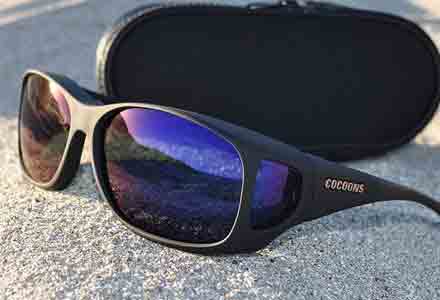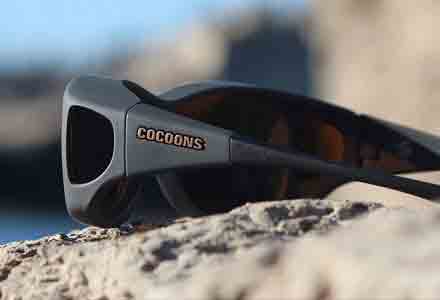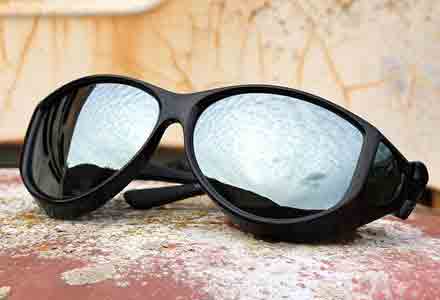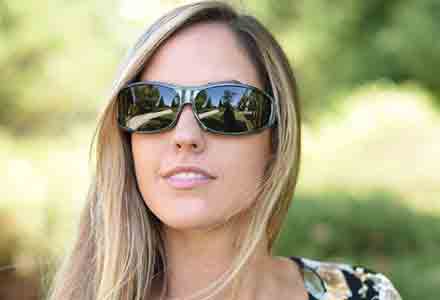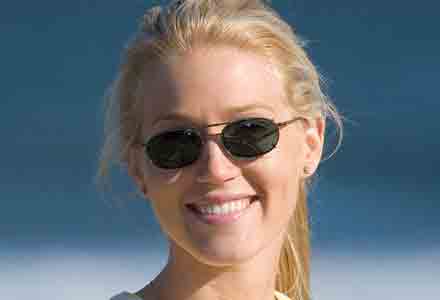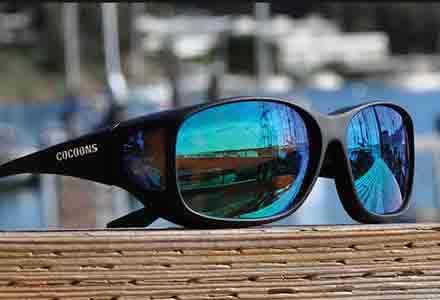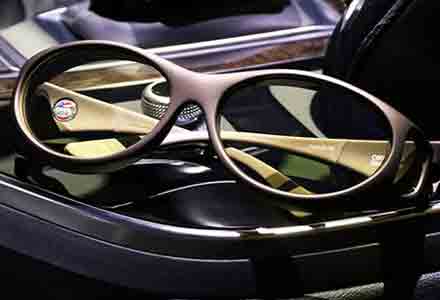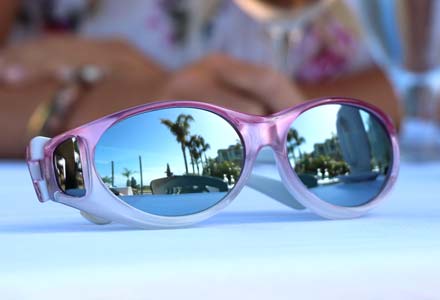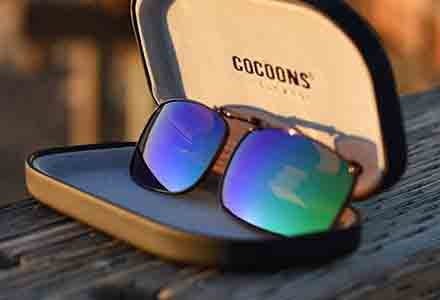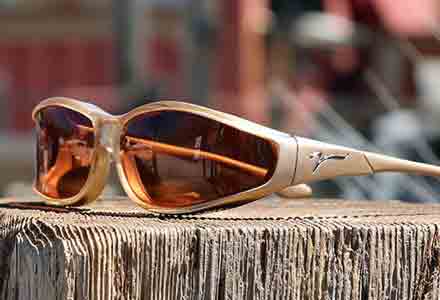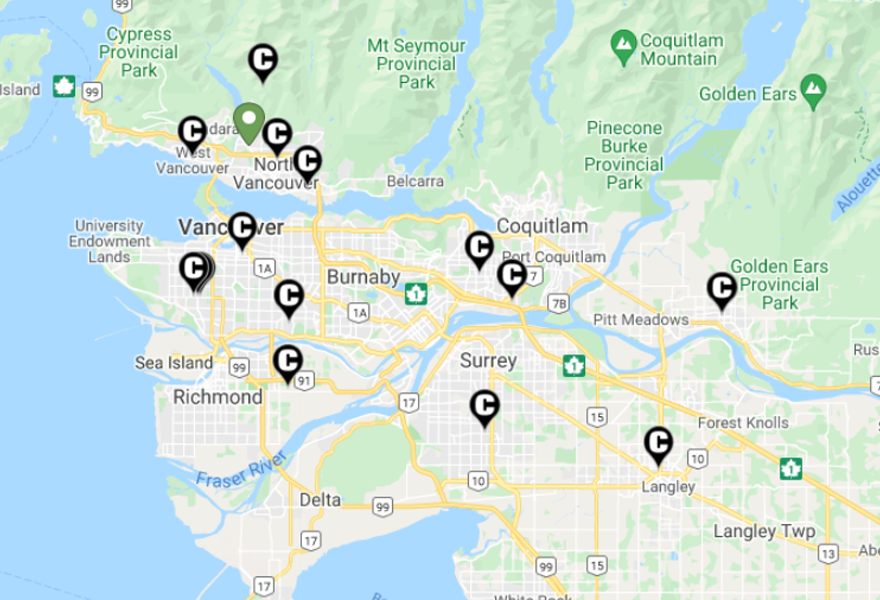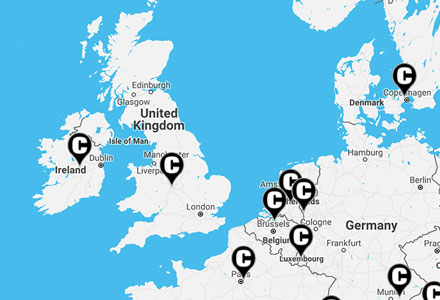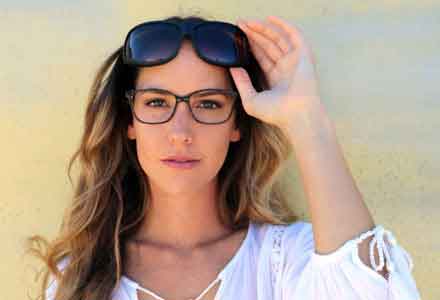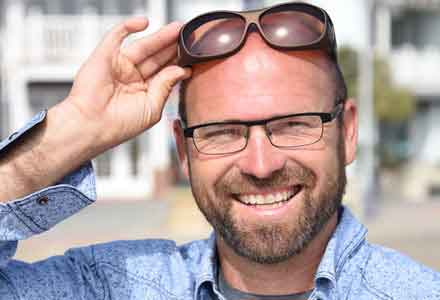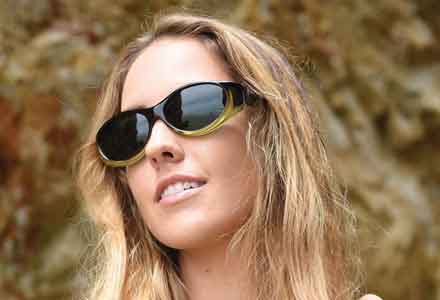UV & Eye Health
UV & Eye Health
How does sunlight damage your eyes?
The sun is far and away the strongest source of ultraviolet (UV) radiation for Earth. UV acts on eyes very much the same as it does on skin: it can cause cancer of the eyes and eyelids, increase the likelihood of cataract formation, and sunburn your eyes. Exposure to UV radiation can immediately weaken vision and, over time, cause irreparable damage to the eyes and eyesight.
What are the different types of UV radiation?
There are three types of UV radiation: A, B, and C. They differ in wavelength as well as biological effects. The following information on each comes from the World Health Organization:
-
- UVC has the shortest wavelength and is the most dangerous and biologically active. Fortunately, UVC is completely filtered by the atmosphere and does not reach the Earth’s surface.
- Medium-wavelength UVB is very biologically active, but it can’t penetrate past superficial skin layers; it can, however, cause tanning and burning. While most UVB is filtered by the atmosphere, research has found that it significantly promotes the development of skin cancers.
- UVA makes up close to 95% of the UV radiation reaching the Earth’s surface. It can penetrate deep into the skin and is also responsible for tanning and burning. Recent studies suggest that UVA can also promote the development of skin cancers.
Can reflected sunlight still harm your eyes?
According to the Vision Council, reflected UV radiation is just as damaging as direct UV. Water reflects up to 100% UV radiation, snow reflects up to 85%, sand and concrete reflect up to 25%, and grass reflects up to 3%. When doing activities in these environments, it is important to wear sunglasses and sunscreen.
What are the peak hours of UV radiation?
UV radiation is strongest when the sun is at its most intense, between 10 AM and 3 PM. However, research indicates that the eye absorbs almost twice as much radiation during peak times for outdoor activities, which tend to be in the early morning (from 8 AM to 10 AM) and in the late afternoon (from 2 PM to 4 PM).
Can UV radiation damage eyes when it’s cold or cloudy?
Temperature has no bearing on UV radiation; UV is always present, and our eyes are always at risk of exposure. While a cloudless sky will generally foster more UV intensity, only around half of all UV radiation comes directly from the sun. According to the Vision Council, the other half is transmitted through both clouds and reflection off of things like streets, buildings, water, snow, and sand.
How do Cocoons help with eye health?
Cocoons are engineered for maximum protection from the elements. Our polarized Polaré lens systems block 100% of UV radiation, and Cocoons frames are injection-molded with a protective brow bar and undercarriage, shielding your eyes from all angles. With any sunglass you buy, make sure it provides 100% UV protection. Even if it has a sticker that says something like BLOCKS UV, it may not shield your eyes completely from both UVA and B radiation.
What defines good blue light vs. bad blue light?
Blue light is sometimes misunderstood, but what is clearly understood by the optical industry is that there is a line between good blue light and bad blue light. As put by one optical professional in an American Optometric Association article on blue light, “We don’t know yet where bad blue light ends and good blue light begins…” That said, there are some basic theories that most professionals agree on. Most agree that everyone needs a certain amount of blue light – the good blue light. This is the light that helps your body’s natural sleep cycle, increases alertness, and can also help with your memory and mood so it is important to not completely eliminate it.
Blue light is not just one colour but instead is infinite. Light is measured in a range of wavelengths, just like radio waves or television signals. On one end of the range is the ultra violet (UV) light. Everyone knows that UV light is bad for the eyes, so it is important that your sunglasses block 100% of these wavelengths. On the other end of the range is the infrared light often associated with television (and other) remote controls. As people, we can only see the light between the UV and infrared light. This is called the visible spectrum (and not all of us can even see that). Scientifically, the visible light wavelengths range from 380 to 800 nanometers(nm). The lower the number on the range, the shorter the wavelength of the light and the more energy the light carries with it. Blue light is at the lower end of this visible spectrum with wavelengths ranging between 400 and 500nm.
Focusing on the blue light range alone, on the low end is the blue-violet light which combines blue light with the really bad UV light. This is generally understood to be the bad blue light. Some sources say the worst blue light exists in the 411-420nm range. As you move to the longer blue wavelengths, the light becomes blue-turquoise in colour. This is the good blue light.
According to a 2014 article published in the Review of Optometry, “The labeled blue-turquoise light range, which is from 465nm to 495nm, is essential to our vision, the function of our pupillary reflex, and in general to human health.” Ultimately, “this blue-turquoise light really plays a vital role in the general health of the individual.” Based on this and other research, it is important to have some blue light exposure. For additional information and guidance concerning blue light exposure, it is recommended that you visit your local eye care professional.
Lens Info
What does polarization do?
Normally, light waves move randomly in an infinite number of directions; however, when light reflects off a smooth surface (e.g.: water, road, car window, snow), it moves more uniformly, intensifying and “polarizing” into reflective glare. Polarized lenses contain a special film between two layers of lens material designed to absorb the polarized waves before they reach your eyes. The film is made of iodine crystals that are positioned in vertical rows. When properly positioned, the polarization film blocks glare, transmitting only usable light. Non-polarized sunglasses reduce visible light; however, they have little or no effect on reflected glare. Only polarized lenses eliminate glare and help you see clearly.
Are Cocoons polarized?
All Cocoons and Vistana fitover sunglasses feature our Polaré polarized lens systems, which deliver maximum polarization efficiency to keep eyes relaxed and focused. Our Twilight Night Drivers and our Low Vision Aids are not polarized, however, as polarization can reduce visibility for LCD and LED screens, which many wearers of those glasses use.
Which lens tint is best for me?
Choosing the best tint depends on what you’ll be using your Cocoons for. All Polaré lenses block 100% of UV radiation, but different lens tints filter types of light differently. If you’ll be in bright daylight, for example, you’ll want a lens that doesn’t let a lot of light in, like a dark gray lens or a mirrored lens. In less intense sun or varying light conditions, however, you’ll want a more moderate lens, like an amber, copper, or yellow–something that sharpens object definition. To find out more about tints that will suit your individual needs best, visit our Polaré Lens page.
Can I wear my Cocoons over my Transition Lenses?
Yes. Many people wear Cocoons with their transition lenses for the benefits of more UV protection, polarization, different lens tints. Transition lenses only activate when they come into contact with UV radiation, and since Cocoons shield your eyes from 100% of UV radiation, your prescription transition lenses will simply not darken.
Can I wear my Twilight lenses during the day?
While Twilight lenses are indeed anti-reflective and 100% UV protective, they feature technology that allows for maximum light transmission, as they are intended for nighttime and low-light use. This means that they won’t necessarily cut down that much on brightness. For daytime use in low-light conditions, we recommend using something like our polarized yellow lens, which improves object recognition and gives a sense of heightened visual acuity.
What do photochromic lenses do?
Photochromic lenses darken and lighten, respectively, with increases and decreases in UV radiation intensity. For example, when you’re out in the bright sun, your photochromic lens will darken, transmitting less visible light than when you’re indoors or in the shade. Both our polarized gray and amber lenses are available in a photochromic option.
Are Cocoons okay for use on a motorcycle?
Cocoons are ideal for motorcycle use. Many motorcyclists prefer Cocoons not only for their unparalleled UV protection, but also for their wind shielding properties and secure fit. The patented frame design, featuring an integrated brow bar, undercarriage, and peripheral side shields, totally protect the eyes from wind and road debris. Moreover, Cocoons’ Flex2Fit temples provide a secure and customizable fit, especially when paired with one of our adjustable lanyards.
Cocoons Features
What features should I look for in a fitover?
In short, you want to make sure your fitover offers you the most protection, comfort, and range of vision. Any fitover worth its salt will provide maximum UV protection; anything less than 100% UVA & B protection simply will not cut it. Moreover, the frame and chassis have to be comfortable and not cumbersome. Too often, people complain of their fitovers being too heavy or ill-shaped for their prescription frames and face shape. Also, peripheral vision is a must. Some fitover manufacturers will neglect to include side shields in their frames, which poses risks to wearers and those around them. With our ultra-protective Polaré lenses, comfortable Flex2Fit Temples, and thirteen unique fitover designs with maximum ranges of vision, we’re committed to providing you with the best fitovers you’ll ever wear.
How can I find the right size for my eyewear?
The best option to find the right size is to use our Size Finder calculators for either Cocoons or Vistana. It’s important to note that these two collections use different sizing methods, so your size will not be the same.
Do Cocoons come in children’s sizes?
We do not have any specially denoted children’s sizes. Our smallest sizes, however (our Cocoons Streamline and our Vistana Small), are very popular among both children who wear prescription eyewear and people of all ages who do not wear prescription eyewear.
How durable are Cocoons fitover sunglasses?
Extremely durable—in fact, they’re virtually indestructible under normal wear. Sure, if you drive your car over them (which don’t do that), the lenses will pop out and the hinge might break, but there’s a good chance you will be able to pop the lenses back in and the sunglasses will be as good as new. Cocoons frames are manufactured from ballistic nylon so durable you can twist the frame inside out and it will pop back into shape with no signs of deformity. Our proprietary Polaré lenses are scratch-resistant and extremely strong (8X stronger than most competitors’ lenses). For additional details on how Polaré lenses outperform standard lenses, see our lens performance report.
What sets Cocoons apart from other fitovers I’ve seen at discount prices?
Functionally, Cocoons are engineered for a lightweight and superior fit, stylish designs, unparalleled sun protection and range of vision, and 100% optical correctness. They’re designed to move with you and help you do whatever it is that drives you. Additionally, Cocoons come with a one year scratch-resistance warranty for all lenses and a lifetime frame warranty—warranties virtually unheard of anywhere else. When you buy Cocoons, you’re not just getting the world’s finest fitover; you’re getting the best customer service in the industry. You can contact us with any questions or concerns you may have, and we’ll help you out immediately or as soon as we can. For additional details on the features, benefits and use and care of your Cocoons sunglasses designed to fit over your glasses, please see our Cocoons Users Guide.
How do I replace the lenses on my Cocoons?
Our Polaré® lens systems are scratch-resistant, but that doesn’t necessarily mean that they’re scratch-proof. After a couple of years of wear and tear, your Cocoons fitover eyewear may just need a new pair of lenses. Fortunately, we sell replacement lenses for nearly all of our frame options online–simply find your size and select your pair. For more information on the best ways to replace your lenses, see the video below:
How do I adjust my Cocoons temples?
Cocoons’ signature Flex2Fit adjustable temples ensure a custom fit that will keep your eyewear secure. They also provide a much more comfortable fit with prescription eyewear; while other plastic temples will cramp over prescription temples, Flex2Fit temples work with and around your prescription temples for maximum comfort. See the video below for more information about how to adjust them:
Warranty & Services
How can I find a dealer near me?
Cocoons are sold in many optical shops around the world. To find a Cocoons dealer near you, visit our Store Locator. For best results, use your ZIP CODE to search. If your search isn’t yielding any results, try expanding your search radius. If you live outside the United States, be sure to use our International Dealer Locator.
What accessories come with my Cocoons?
All Cocoons come with a soft, durable neoprene Cocoons case and an ultra soft lens cloth. More accessories including lanyards and jumbo cleaning towels are available in our Accessories Shop.
What post-purchase services am I entitled to?
With your purchase, you have exclusive access to our industry-leading warranty as well as our unparalleled customer service. We’ve been heralded time and time again for our tireless dedication to Cocoons wearers across different platforms of communication including phone, email, and social media. If you have a question or concern, we’re happy to walk through or create a solution with you–just give us a call or shoot us an email.
How can I tell if my Cocoons are genuine?
If you bought your Cocoons from an authorized dealer, you have nothing to worry about—your Cocoons are the real deal, and you’re entitled to all of the benefits of owning them. We strictly regulate the online and brick-and-mortar vendors who can carry Cocoons, and we encourage you to get in touch with us if you have any questions about whether or not the vendor you’re considering is authorized. Otherwise, the OveRx trademark is attached to all Live Eyewear collections of fitovers to signify that they meet our standards; when you see the OveRx logo, you can trust that no facet of the eyewear’s design has been overlooked.
What is your return/exchange policy?
We offer an exclusive 30 day money-back guarantee. If you don’t completely love your Cocoons or you’ve decided that you would like to exchange what you ordered for a different item, please contact our customer service team at 800.834.2563 or by email at info@cocoonscanada.ca for assistance with your return or exchange. For additional details and instructions concerning returns and exchanges, please see our Product Returns Policy.
What are the details of your warranty?
We are very proud of the durability and quality of Cocoons. Thus, we warrant all defects in material and workmanship to the original purchaser for life. All products will be replaced or repaired at the discretion of Cocoons. Determination of warranty status is made solely by Cocoons. Repairs will be made by Cocoons, as no one else is authorized to make repairs. Unauthorized repair attempts will void all warranty claims. You can learn more, register your warranty, or file a claim for a replacement or repair in our Warranty Centre.
How can I keep up with Live Eyewear?
Our diverse fitover eyewear collections offer patented features and optical-grade components that deliver professional grade quality, performance, comfort and style. Our mission is to meet the daily UV protection needs and style choices of everyone, and we’re always experimenting with new designs and offers. To see our full selection of fitover sunglasses, clip-ons, flip-ups and UV filters, download the Live Eyewear Catalog. To keep current on the latest eyewear collections, events, and special offers, “like” Cocoons Fitovers on Facebook and follow us on Instagram!

